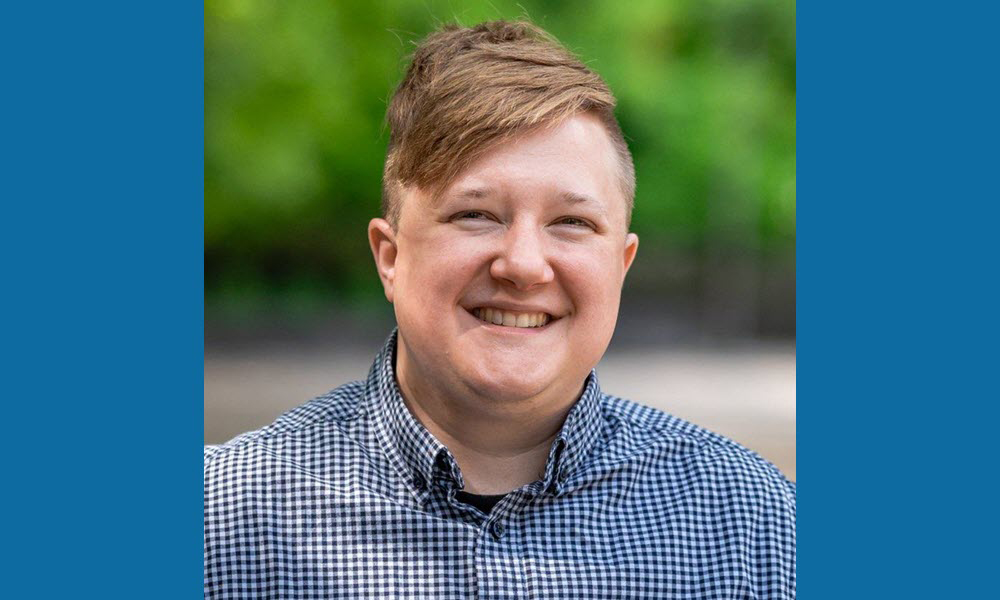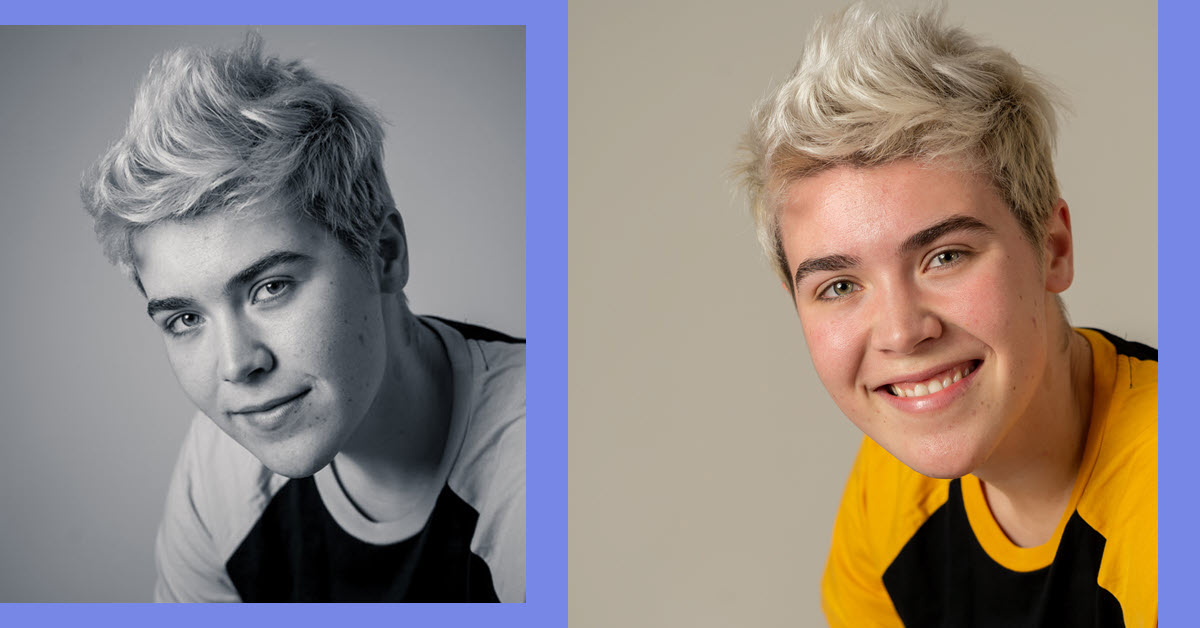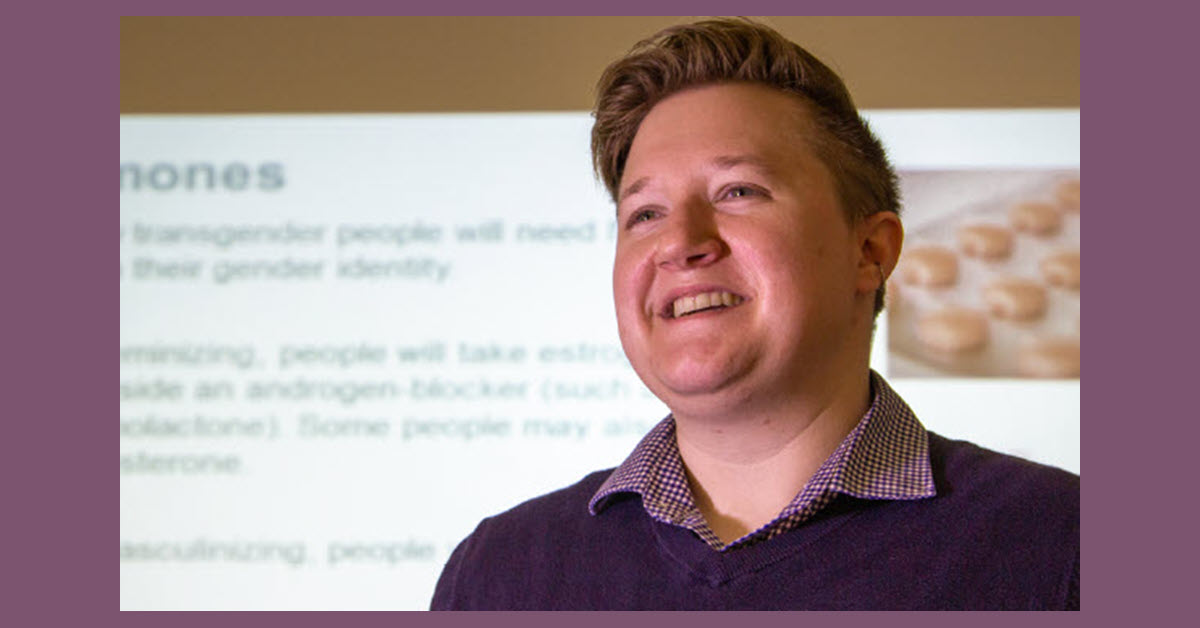
Charlie Borowicz, MSW, MPH, program manager for the Transgender Health Program at AHN.
"Trans people have always been here — this isn't rare and we are not going away," says Charlie Borowicz, program manager for the Allegheny Health Network (AHN) Transgender Health Program. "We're just trying to survive."
Challenges to "just trying to survive" come from multiple directions for the approximately 5 million Americans who are transgender or nonbinary. In addition to the familial rejection and societal misunderstanding and hostility experienced by many transgender people, they have become a frequent political target; of the record number of bills introduced so far in 2022 to limit LGBTQ rights, about half target transgender people specifically.
Borowicz notes that there are also gaps in health care for transgender and nonbinary people. From lack of access to interpersonal and systemic rifts to a general fear of discrimination, trans people may not get routine or even urgent health care, negatively impacting their well-being, risk of chronic illness or need for emergency care, mental health, and more.
The Transgender Health Program, part of AHN's Center for Inclusion Health, helps bridge those gaps with a combination of services, care navigation, patient support, and system-wide training. Borowicz sat down to talk with me about their work and some broader issues as well.
Emily Laubham: What does your role at the Transgender Health Program entail?
Charlie Borowicz: Anything trans-related at AHN eventually winds up on my desk. Since 2019, we have done a lot of training for residents and departments, as well as making connections and figuring out who is doing what work for trans health in primary care, endocrinology, surgery, and other disciplines.
When the pandemic started, training stalled temporarily, at which point I shifted into patient support. These days, my work is a combination of provider training, patient support, and employee support. I've also had a hand in changes to our electronic medical records and discussions around policy changes for both medical and employment practices. A lot of existing policy was written by cisgender people. It's not anything malicious, but there wasn't any input from trans people.
Emily Laubham: What services does the program offer?
Charlie Borowicz: The primary focus for the program itself is patient care navigation, advocacy, and support. People can call us about anything — from needing a new provider to prescriptions for hormones to navigating surgery.
We also take patient feedback, which helps with recommendations. If someone who is transgender has a good experience with a provider, we want to pass that information along to others. If there is an experience that’s not so good, it's an opportunity for us to reach out about provider training.
In our context, care navigation is mostly about identifying and vetting gender-affirming providers and then connecting people to them. So, if someone tells us their cardiologist was affirming and welcoming, for example, we’ll still follow up before we add their name to our database and share it with other patients.
Once we've matched someone's needs with the right provider who provides gender-affirming care, we sometimes find that they're booked out far in advance, so there are still accessibility challenges, which underscores the importance of having more gender-affirming providers.
Emily Laubham: What is gender-affirming care?
Charlie Borowicz: Gender-affirming care includes anything that alleviates gender dysphoria or stress caused by gender incongruence, allowing people to be their authentic selves. This could be puberty blockers for children and adolescents, gender-affirming hormone therapy for adolescents and adults, and various types of surgery, including facial surgery, tracheal shaves, reproductive organ removal, chest masculinization or augmentation, and any kind of genital reconstruction surgery. It also includes things like hair transplant and removal.
Emily Laubham: Does gender-affirming care also go beyond transition-related services?
Charlie Borowicz: Yes, there are circumstances where specialty providers have the opportunity to provide gender-affirming care, too. Cardiology is a good example. If you have someone with cardiovascular risk who is on testosterone, gender-affirming care would not just cut off the testosterone, because there would be the understanding that testosterone is also medically necessary. Instead, the goal would be to do a kind of risk analysis, allowing the patient to understand different risks involved and make an informed choice about their care.
Also, it’s important to note that trans people don’t have to take hormones or have gender-affirming surgery to be trans. Some don’t have access to these services, and others choose not to pursue them.
Emily Laubham: Can you talk about the importance of using inclusive language with patients?
Charlie Borowicz: Language changes with culture, not the other way around. It’s important to learn what it means to be affirming and welcoming and stay open to using new language, because language is constantly developing.
In general, I want to shift our thinking on inclusive language. It usually gets tied up in the conversation about political correctness, and I hear things like, “You never know what’s going to offend people these days.” But it’s not about offending people so much as it’s about showing basic respect. Everyone in the room should feel respected. Using non-inclusive language also prevents you from getting the full picture of who someone is.
Providers and patients should know that it's a policy violation at AHN to continuously use incorrect names and pronouns and intentionally misgender somebody. Mistakes happen, so there is a balance, but part of our provider training and awareness is not just managing mistakes but also preventing them from happening.

Borowicz points out that "using non-inclusive language also prevents you from getting the full picture of who someone is."
Emily Laubham: What kinds of training and education do you use?
Charlie Borowicz: Generally speaking, I come in and do a group presentation that's either a 30- or 60-minute interactive PowerPoint. The presentation is also available on My Learning for people with staffing or timing issues. I do tailored training, too. For example, after our interview, I'll be meeting with labor and delivery, and then later today I'm meeting with dentistry. There are different issues to think about depending on the type of care. I also have a list of target areas that are more likely to see trans people in a context where it could become uncomfortable. Urogynecology is a perfect example — so there we're proactively doing outreach to reduce the risk of bad experience.
We do provider mentorships as well. For example, I have some primary care providers (PCPs) who want to do hormone therapy but don't know how. They'll start with one or two patients and a more experienced provider will get them up to speed. Then I'll come in and do their office training.
I really encourage people to ask any questions they have. People sometimes worry that they're going to hurt my feelings, but I assure them I've heard everything twice, and I wouldn't be doing this work if I didn't want to talk about all the issues. I just want people to be open to some information and facts that might be new to them.
Emily Laubham: Have you had a good response from providers?
Charlie Borowicz: It's been extraordinary. I've done training for three years with thousands of employees, and I can count on one hand the number of negative responses. Even those instances mostly stemmed from discomfort with new information or doing things differently, not malice. No one gets into health care to hurt people.
Emily Laubham: What does the mental health landscape look like for gender-diverse people?
Charlie Borowicz: Generally speaking, we see stress, anxiety, depression, hopelessness — national percentages for things like depression, post-traumatic stress disorder (PTSD), eating disorders, and other conditions are higher for trans people.
The day-to-day landscape often has a lot of isolation, lack of community, and a constant assault on our rights from all directions. More and more states are trying to pass anti-trans legislation. It's scary, and it feels like we’re going backwards. It's important to acknowledge the impact that has.
Emily Laubham: For some gender-diverse people, there may be negative impacts from their own family. What would you say to parents or guardians who don’t understand or approve and are responding with fear or anger?
Charlie Borowicz: Just love your kids no matter what. Even if you don't agree with or understand them, there are still ways to support them. No amount of rejection, yelling, or therapy will change who they are.
When you look at kids who are rejected by their family, the incidence of things like homelessness, substance use, HIV infection, and suicide skyrocket.
Emily Laubham: Even if providers aren't anti-trans per se, more subtle kinds of stigma or misunderstanding can still lead to a stressful or frustrating patient experience. I'm sure the provider training helps, but does recognizing and reducing stigma and implicit bias also require a more personal kind of commitment?
Charlie Borowicz: Training and education are important, but people also need to meet more trans people. It hasn't been published yet, but we did a research study which showed that when internal medicine residents met and interacted with just a handful of trans people, their attitudes shifted in a positive direction. So, not only did their knowledge and understanding increase, which you would expect, but interacting had a broader personal impact.
Emily Laubham: Do we need more clinical data that includes trans and nonbinary people?
Charlie Borowicz: Yes. There has been some progress, but we need so much more — there are many areas where we just don't have data to draw conclusions from at this point. I want to emphasize that we need to diversify clinical research and include gender diversity in all research areas, not just research about gender diversity specifically.
Emily Laubham: Is there also a need for more inclusion and representation in terms of hiring in health care?
Charlie Borowicz: Absolutely. We need more diversity among health care providers in general. Trans people face barriers in education, including issues with IDs, systematic discrimination, and accessibility. Many trans people are rejected by their families and lose that layer of familial, financial, and emotional support. So those challenges have to be addressed in order to increase the number of transgender providers.
Emily Laubham: What would you say to trans and nonbinary readers who may be avoiding health care because they have felt unseen or unsafe in the past?
Charlie Borowicz: You have a place here. You have every right to be here as a patient, as an employee, as part of the community, and to get the same level of respect and support and care as anyone else.

Charlie Borowicz doing a training session. Photo by Brian Duncan, first published in AHN Autoimmunity Institute newsletter, September 2021.
Emily Laubham: What does progress look like in terms of transgender health?
Charlie Borowicz: One tangible thing we've made progress on is electronic medical records. We had the ability to have preferred names in our system, but now that's more visible. We also added pronouns, and made it possible for people to list their gender identity if they choose to. All of this helps someone to present themselves the way they want to and helps providers get a more accurate picture of the patient.
For me, at a high level, progress is about providers wanting to know more and knowing who to call with questions. Our program existing as a resource in a health system of this size is progress, and we want to keep building on that and increase the number of people we reach.
In terms of policy, there is a lot of inconsistency in what procedures and surgery are covered, so I'd like to see the better coverage policies become the standard instead of the exception. That would include covering things like facial surgery and hair removal, for example. In our region and elsewhere, another big challenge is access to what is colloquially called bottom surgery. It's not easy traveling anywhere for any surgery, let alone for something like that.
Emily Laubham: What is your wish list looking over the next few years for AHN's program?
Charlie Borowicz: I would like there to be more of a hub or center where people can come in for multiple services. For now, our model is focused on pushing knowledge to all corners of the system, which is very important. But combining more services in a singular clinic setting would have many benefits for the people we serve, including reducing barriers related to transportation.
To be clear, that doesn't mean creating one place where all the transgender people get "sent." That would defeat the purpose of integrating gender diversity training across the entire system — we want someone to have a good experience no matter where they go. But, in addition to that, we could also have a center similar to a center for diabetes for example, so we can help people with complex needs that require multiple services in one place instead of them needing to get to multiple appointments and locations.